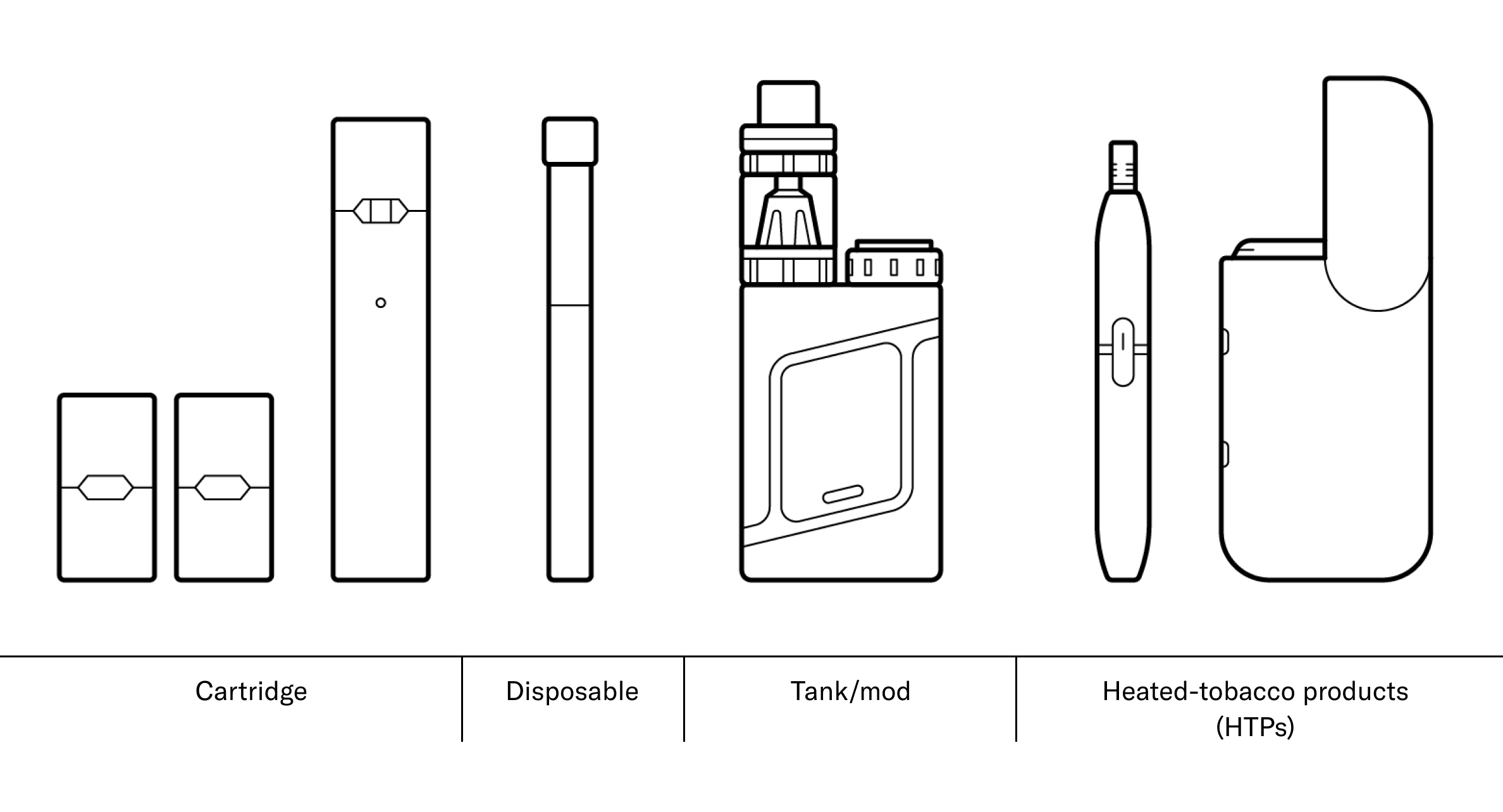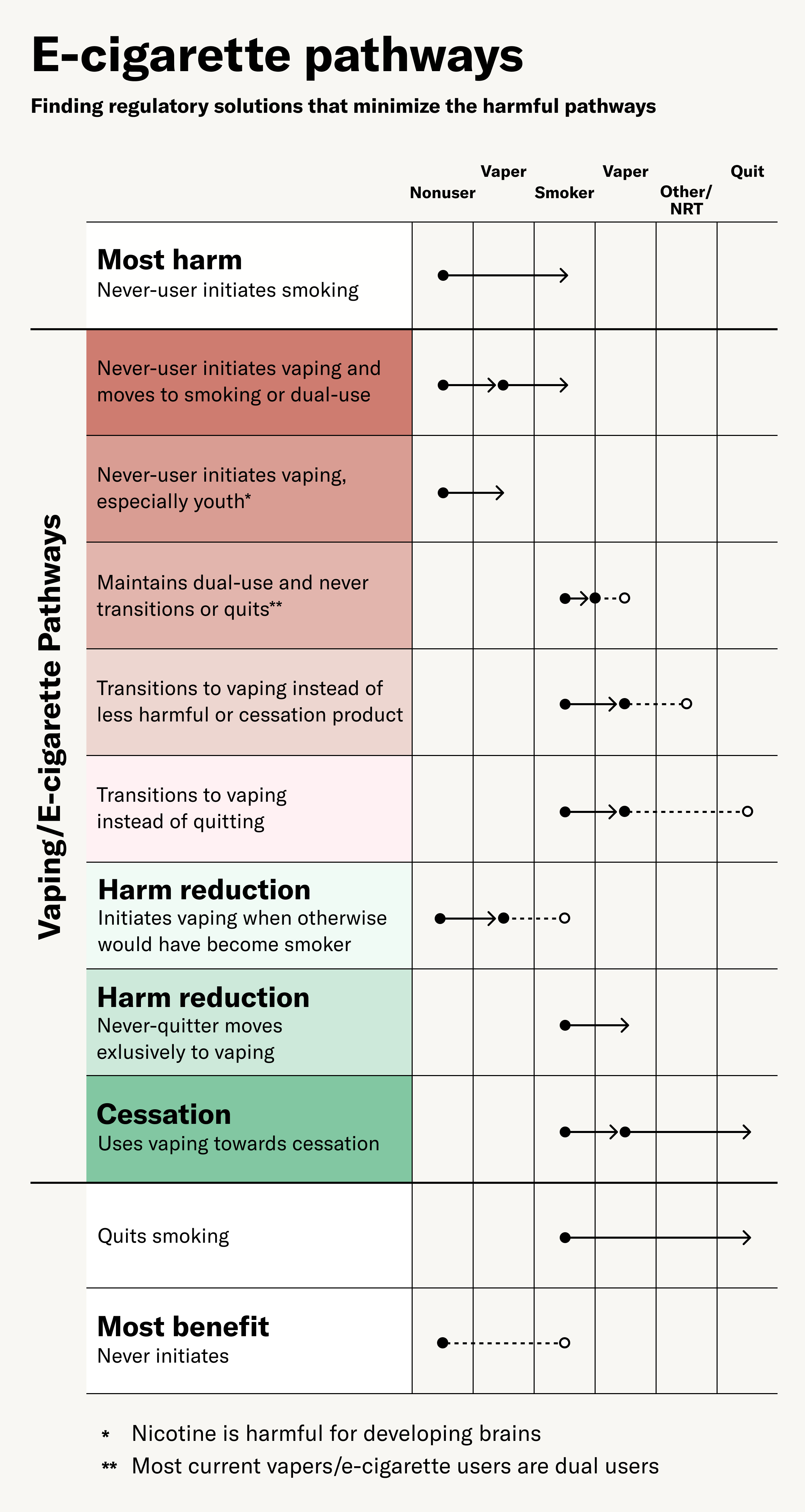References
Maps (adult and youth):
Various national surveys – list available upon request.
Review of overall e-cigarette harms:
National Academies of Sciences, Engineering, and Medicine. Public health consequences of e-cigarettes. Washington, DC. 2018.
E-cigarettes and cessation:
Hartmann-Boyce J, McRobbie H, Butler AR, Lindson N, Bullen C, Begh R, Theodoulou A, Notley C, Rigotti NA, Turner T, Fanshawe TR. Electronic cigarettes for smoking cessation. Cochrane database of systematic reviews. 2021(9).
Kaplan B, Galiatsatos P, Breland A, et alEffectiveness of ENDS, NRT and medication for smoking cessation among cigarette-only users: a longitudinal analysis of PATH Study wave 3 (2015–2016) and 4 (2016–2017), adult dataTobacco Control Published Online First: 15 September 2021. doi: 10.1136/tobaccocontrol-2020-056448.
E-cigarette advertisements
Jackler R. Research into the Impact of Tobacco Advertising. Palo Alto: Stanford University. Website: https://tobacco.stanford.edu/ecigs/.
Gateway:
Chan GC, Stjepanović D, Lim C, Sun T, Shanmuga Anandan A, Connor JP, Gartner C, Hall WD, Leung J. Gateway or common liability? A systematic review and meta‐analysis of studies of adolescent e‐cigarette use and future smoking initiation. Addiction. 2021 Apr;116(4):743-56.
Harms of dual use:
Reddy KP, Schwamm E, Kalkhoran S, Noubary F, Walensky RP, Rigotti NA. Respiratory Symptom Incidence among People Using Electronic Cigarettes, Combustible Tobacco, or Both. Am J Respir Crit Care Med. 2021 Jul 15;204(2):231-234. doi: 10.1164/rccm.202012-4441LE. PMID: 33857396.
Toxicants:
Tehrani, Mina W.; Newmeyer, Matthew N.; Rule, Ana M.; Prasse, Carsten (2021): Characterizing the Chemical Landscape in Commercial E‑Cigarette Liquids and Aerosols by Liquid Chromatography–High-Resolution Mass Spectrometry. ACS Publications. Collection. https://doi.org/10.1021/acs.chemrestox.1c00253.
Maps (adult and youth):
Various national surveys – list available upon request.
Review of overall e-cigarette harms:
National Academies of Sciences, Engineering, and Medicine. Public health consequences of e-cigarettes. Washington, DC. 2018.
E-cigarettes and cessation:
Hartmann-Boyce J, McRobbie H, Butler AR, Lindson N, Bullen C, Begh R, Theodoulou A, Notley C, Rigotti NA, Turner T, Fanshawe TR. Electronic cigarettes for smoking cessation. Cochrane database of systematic reviews. 2021(9).
Kaplan B, Galiatsatos P, Breland A, et alEffectiveness of ENDS, NRT and medication for smoking cessation among cigarette-only users: a longitudinal analysis of PATH Study wave 3 (2015–2016) and 4 (2016–2017), adult dataTobacco Control Published Online First: 15 September 2021. doi: 10.1136/tobaccocontrol-2020-056448.
E-cigarette advertisements
Jackler R. Research into the Impact of Tobacco Advertising. Palo Alto: Stanford University. Website: https://tobacco.stanford.edu/ecigs/.
Gateway:
Chan GC, Stjepanović D, Lim C, Sun T, Shanmuga Anandan A, Connor JP, Gartner C, Hall WD, Leung J. Gateway or common liability? A systematic review and meta‐analysis of studies of adolescent e‐cigarette use and future smoking initiation. Addiction. 2021 Apr;116(4):743-56.
Harms of dual use:
Reddy KP, Schwamm E, Kalkhoran S, Noubary F, Walensky RP, Rigotti NA. Respiratory Symptom Incidence among People Using Electronic Cigarettes, Combustible Tobacco, or Both. Am J Respir Crit Care Med. 2021 Jul 15;204(2):231-234. doi: 10.1164/rccm.202012-4441LE. PMID: 33857396.
Toxicants:
Tehrani, Mina W.; Newmeyer, Matthew N.; Rule, Ana M.; Prasse, Carsten (2021): Characterizing the Chemical Landscape in Commercial E‑Cigarette Liquids and Aerosols by Liquid Chromatography–High-Resolution Mass Spectrometry. ACS Publications. Collection. https://doi.org/10.1021/acs.chemrestox.1c00253.







